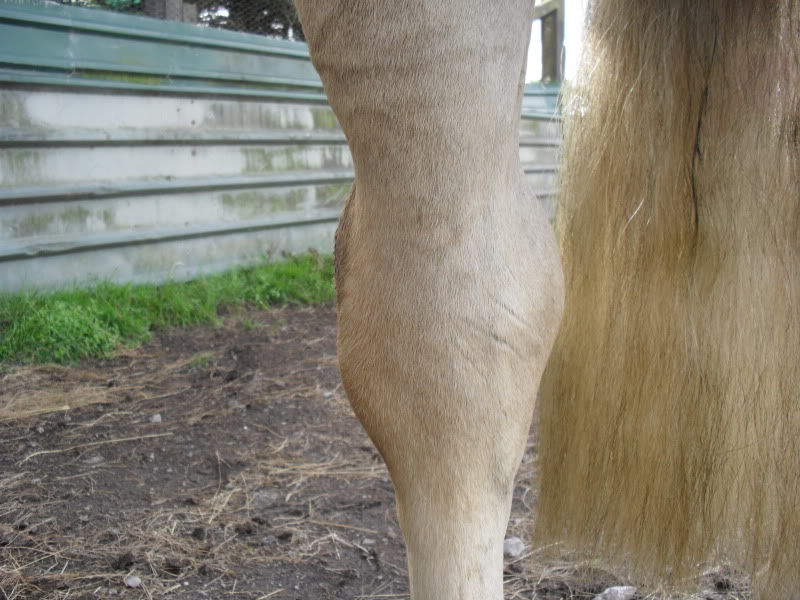 While most pleasure horse enthusiasts are familiar with hock issues in their horses, one of the more confusing hock problems can be swelling of the hocks.
While most pleasure horse enthusiasts are familiar with hock issues in their horses, one of the more confusing hock problems can be swelling of the hocks.
The hock area of a horse is actually comprised of four different joint spaces. The upper hock joint, also known as the tarsocrural or tibiotarsal joint, is the joint that is responsible for 98 percent of the motion of the joint. While the other joints have a little bit of motion within them, the joint capsules are not that big and usually don’t have much swelling associated with them. Most commonly, swelling of the hocks is associated with the upper hock joint.
OCD Lesions In a younger horse – usually under 3 years of age, but it may be noticed as early as a yearling – severe swelling of the upper hock joints can be caused by an OCD lesion. OCD, or osteochondrosis dessicans, is a growth abnormality of the bones. There is no known exact cause of OCD, but it is considered to be caused by mineral deficiencies and fast growth. There are two areas where OCD occurs most commonly in the upper hock joint – the intermediate ridge of the distal end of the tibia, and the lateral trochlear ridge of the talus. OCD also commonly happens bilaterally – so both hocks are likely to be affected.
Often, owners will notice a young horse will suddenly appear to have swelling in one or both hocks. The horse may not be lame, and there is no heat associated with the swelling. If swelling is noticed, it is important to have the swelling evaluated as soon as possible, and radiographs taken to look for OCD lesions. It is recommended that OCD lesions in the hocks be removed surgically. If OCD lesions are discovered in a horse that is not lame, surgical removal can be curative and the horse is much less likely to develop lameness issues and can likely have a good athletic career. If a wait and see approach is taken, and lameness develops, it can be much more difficult to return the horse to athletic soundness.
Joint Infection Joint infection is serious and life threatening, no matter the age of the horse. Joint infection is caused by the introduction of bacteria or, less commonly, fungus, into the joint space. The infectious agent reproduces rapidly in the joint, and creates joint swelling, heat and nonweightbearing lameness.
In a very young foal (day to weeks old), joint infection can be caused by sepsis, or the spread of a serious blood infection. Sepsis is a common complication of failure of passive transfer – a foal not receiving enough colostrum and not absorbing the antibodies that protect it against such infections.
 Joint infections can also be caused secondary to trauma to the joint – a puncture wound or cut over the upper hock that enters the joint space, and allows bacteria to enter the joint space. It also can be secondary to a joint injection – the needle used for the injection carries the bacteria from the skin into the joint fluid. The wound may be very obvious, or may not be visible to the naked eye. If you ever suspect a wound is near any joint space, it is important to have the wound examined by your veterinarian ASAP. Joint infections that are treated early and aggressively have better outcomes than those that have delayed treatment. A joint infection can have other disastrous complications, like sepsis and laminitis.
Joint infections can also be caused secondary to trauma to the joint – a puncture wound or cut over the upper hock that enters the joint space, and allows bacteria to enter the joint space. It also can be secondary to a joint injection – the needle used for the injection carries the bacteria from the skin into the joint fluid. The wound may be very obvious, or may not be visible to the naked eye. If you ever suspect a wound is near any joint space, it is important to have the wound examined by your veterinarian ASAP. Joint infections that are treated early and aggressively have better outcomes than those that have delayed treatment. A joint infection can have other disastrous complications, like sepsis and laminitis.
Bog Spavin Bog spavin is considered to be excess joint fluid in the upper hock joint. It is a diagnosis of exclusion – once you have ruled out the other more serious causes of joint swelling, excess fluid in the upper hock joint will often be diagnosed as bog spavin.
The severity of the fluid fill of the upper hock joint with bog spavin is significantly less than seen with OCD lesions, and there is no heat associated with it. Often you can push on the soft swelling on the outside of the hock, and watch the fluid fill move to the inside of the hock. There also will be no lameness noted with bog spavin. It will more commonly be seen in horses that are older than 3, and who currently are being worked or are in a training program.
Bog spavin can be caused by strain on the hock joint – so a horse with lower or middle hock joint discomfort may put abnormal stresses on the limb, which predisposes it to this swelling. Conformation like very upright hocks can also predispose a horse to bog spavin. Once the joint capsule is stretched, it will not go back to its original shape, and will likely always carry some excess fluid.
Tanis MacDonald Walker, DVM graduated from the Atlantic Veterinary College on Prince Edward Island and currently practices both small animal emergency and equine medicine in Delaware. You can email her at tanis_macdonald@hotmail.com or visit her at www.drtanis.com. You can also write to her in care of InStride Edition.


You must be logged in to post a comment Login